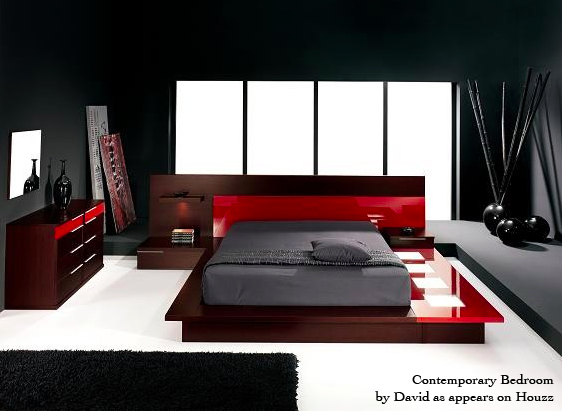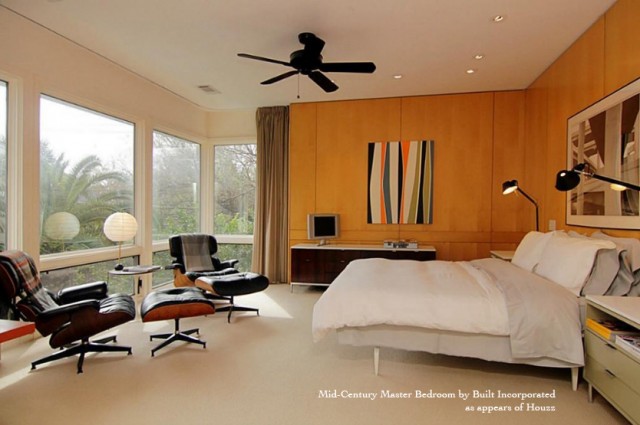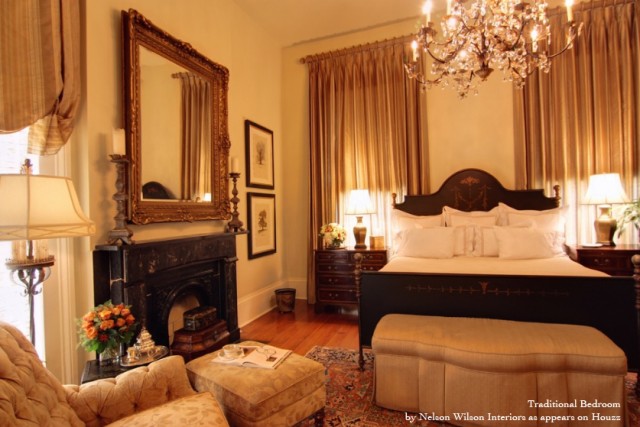Tag Archives: Design
Bedroom Design: Reading Nooks for Kids’ Rooms
Post by Stephanie Noble.
Teaching my son a love of books and reading is one of the great joys I have discovered since becoming a parent. He is lucky to have family and friends who gift him with clever books that engage him so completely that many of his first words came from books. Currently, we have a small corner of our living room devoted to our books. They fill vertical shelves that we installed to fit a corner that was dead space -tough to utilize because of a window on one side and a door on the other. While this is a perfectly serviceable solution for our small space, I dream about creating the perfect reading hideaway for my boy. A cozy corner of his bedroom devoted to losing himself in stories.
Pinterest.com is a great place to assemble ideas for this dream. I’ve been pinning ideas for the last year. Pulling bits and pieces out of different designs to implement when the time comes for the reality, I’ve created what I hope will one day become his imagination nook.
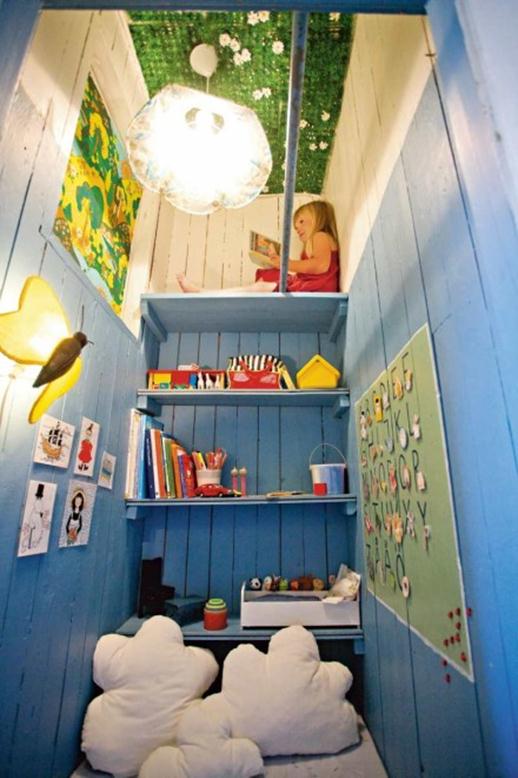
Because he loves to climb, I visualize a vertical space with a space for books, found treasures and space for his artwork. I’m just not certain how this little girl accessed her reading shelf. I would add a ladder.
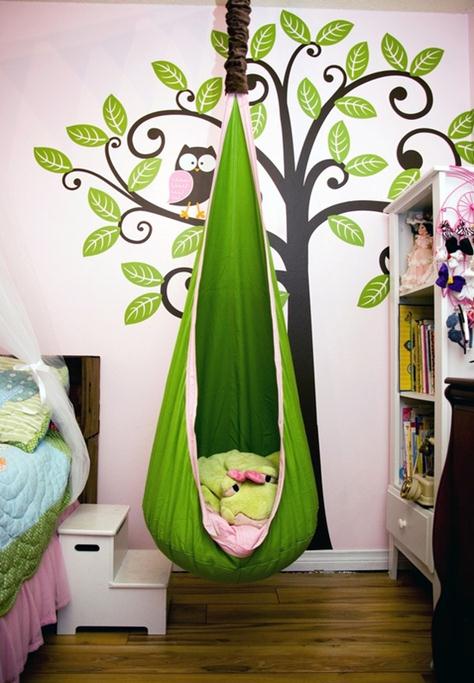
In our current home, this swinging seat might have to replace an entire nook. It would still give him a spot to cozy up with a book that would feel different from the rest of the house.
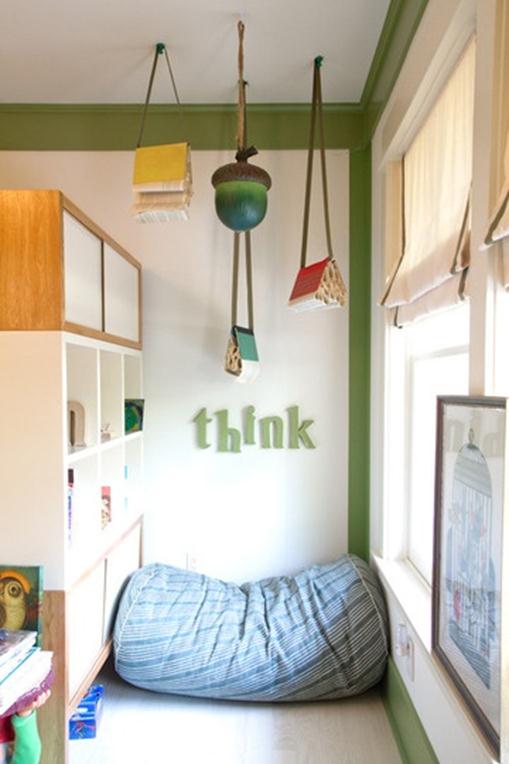
If possible, I’d like there to be a lot of natural light, so he doesn’t strain his eyes. Also, so that he can pause and look out the window to dream about the world. In this picture, I like the books hanging from the ceiling. Excess books are being turned into great art, I’d like to include some book art in his space.
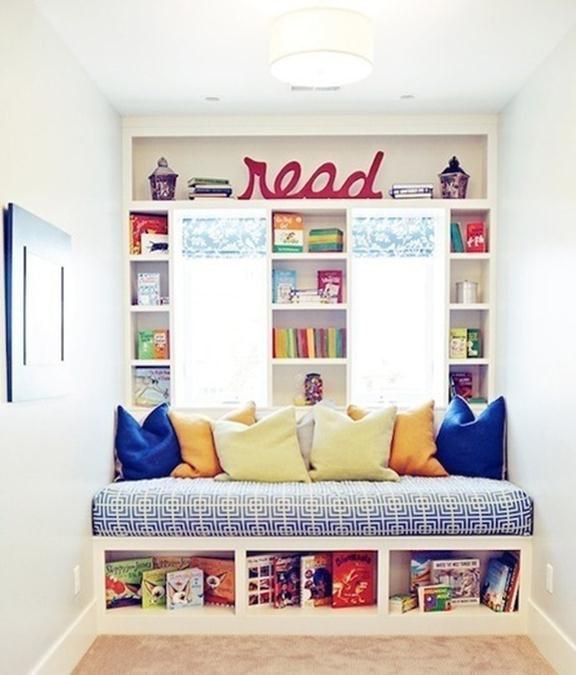
If the vertical plan doesn’t work out, a window seat is a classic reading space. I like the built in shelves in this space. I know that it has been styled for this photograph, but I laugh thinking what it would look like after a child took control of the space. I think that’s the most important thing to remember when designing a kid’s space. An adult has a perfected magazine perfect concept that may last for one brief moment before the child takes possession. Then a beautiful chaos will ensue. That chaos is the point at which the child makes the space his or her own. It’s important to not become so attached to the design that you’re unable to let go and let the space become the child’s space.
Things We Like: Eclectic Bedroom Design
Post by Kyle St. Romain.
Last week we distinguished modern and contemporary design. While the two terms are sometimes used interchangeably, they convey two distinct meanings: modern design refers to a specific era of design (1920-1970) and many of the more popular pieces from this time are dubbed “20th Century Classics,” while contemporary design refers to a blend of design that embodies a more transient style characterized by what’s popular today. The two can often look similar, but rest assured they are quite different. The devil’s in the details.
Today, I want to discuss my favorite design style: eclectic design. I’ve been told before that you have to be rich to be eclectic; otherwise you’re just weird, though I like to think that’s not the case. Eclectic design is really hard to pin down, but you’ll know it when you see it.
Eclectic design is really a combination of all design styles that just works. Indeed, eclectic is defined as: “deriving ideas, style, or taste from a broad and diverse range of sources. To achieve an eclectic design, people often use traditional furniture pieces and accent them with bold colors and a variety of decorative pieces. I find that a warehouse style loft condo is the best canvas to turn eclectic, since the exposed ceilings and ductwork offers a strong contrast to just about anything you put in the space.
What draws me the most to eclectic design is that it allows you to completely personalize your living space. Rather than being stuck to a particular theme or style, you’re free to do just about whatever makes you happy. That said, you do need to have an overall plan in mind for your space even if it doesn’t come together all at once. Basic design principles like rhythm and balance are very important when designing with an eclectic palette since you won’t be able to rely as much on uniformity in your furnishings like you would if you stuck to a more conventional style of design. For example, the visual weight of traditional furniture may be harder to balance with modern accent pieces; whereas, if you used all traditional or all modern furnishings they would more easily balance right out of the box.
The best way to perfect an eclectic design in your bedroom, or throughout your home, is to experiment with various furnishings, colors, and decorations to find out what works best in your space. As always, a low risk way to get a feel for eclectic design is to comb over photos of how others have done it, successfully, before. Houzz has a great gallery for eclectic bedrooms, which you can view here.
What style of design speaks to you the most? Let us know in the comments below.
Bedroom Design: Quick Change: A Tale of Two Lampshades
Post by Erin Sears.
In looking for ways to take my own bedroom design advice and begin again, I started assessing the contents of my bedroom. What do I love? What feels not-so-much? After taking a visual tour of the space, my eye kept getting stuck on my bedside lamps. The base of each lamp is fabulous (I am not humble about my own good taste), but one of the lampshades felt particularly ho-hum.
Here’s the story and what I did about it:
The first lampshade: Ordinary. Hard to clean and rapidly yellowing (gross). Similar to the one pictured below.
Source: lightingforum.com
Here’s the thing: Many lamps that you buy in mid-range home furnishing stores or from catalog outlets are great design choices, but they usually come with plain lampshades so that they can be easily integrated into the scheme of any room. But you don’t live in just ANY room, do you? Certainly not! You LIVE in YOUR rooms. Time to switch things up! (pun intended)
While I was back in the Midwest for the holidays, I took a trip to the Happiest Place on Earth, also known as Target, with my dear mother. Target has a new line of home goods called Threshold and I was instantly enamored with the look and quality of many of the products. In the lighting section, I stumbled across this beauty:
The second lampshade: Ombre glory. Sea and sand magic.
Source: target.com
Knowing it wouldn’t fit in my suitcase I put my ownership ambitions on hold and hoped that the lampshade could also be found at my local store. When I arrived it was in stock and for a cool 23 bucks it became MINE. And you know what? This little change has made all the difference. It easily took my bedroom design up a notch.
Here are some other gorgeous options for lampshades that really light me up:
Source: hillarythomas.com
Emily Wagner Handpainted Lampshade $99
Source: target.com
Threshold Blue Ikat Print Lampshade $22.99
Source: target.com
Threshold Mix and Match Trellis Shade $14.99
Source: Anthropologie.com
The Myriad Horizons Lampshade $98-$118
When in doubt, try a new lampshade! Really. Setting my sights on subtle bedroom design upgrades has proven to be transformative and oh-so-very pleasing. What can you switch up?
Bedroom Design: Contemporary vs. Modern vs. Traditional Design
Post by Kyle St. Romain.
While most people have a general idea of the way they want their bedroom to look, many use the wrong words when trying to describe this vision to other people. While minor differences in terminology go mostly unnoticed when talking amongst friends, the same words carry distinctly different meanings to professionals in the design community. To help you nail down the terminology, we’re going to discuss contemporary, modern, and traditional design and the main differences between each.
Contemporary Design
Contemporary design, also called transitional design, can be described as a mix of modern and traditional design. Unlike modern design, which describes a specific style from a particular era, contemporary design embodies what is “in” today. Indeed, the word contemporary means “with the time, “or “modern, characteristic of the present.” Contemporary can even be further described in terms of its geography. Thus, today’s contemporary design in California may be very different from today’s contemporary design in New York.
Some of the cornerstone elements found in contemporary design today include shiny, reflective surfaces like glass and stainless steel. Contemporary furniture is a bit bulkier and more rounded than modern furniture, but is more minimalistic than traditional furniture. Contemporary design often features very artistic lighting fixtures, which are commonly used as the statement piece in a room.
Modern Design
Modern and contemporary design are often confused and while they are similar, modern design refers to a specific era of design while contemporary design changes with the present. Modern design refers to an era of design from the mid 20th Century (1920s – 1970s) and many of the most famous furniture pieces and designers from this era are referred to as 20th Century Classics. Modern design incorporates clean lines, bright and open spaces, and the use of natural materials. During the mid 20th century, the idea of “form follows function” was prominent, and you’ll find that modern furniture is surprisingly comfortable—even if it doesn’t look like it will be.
Traditional Design
While it’s rare to confuse traditional design with modern or contemporary design, it’s important to briefly hit on traditional design since contemporary design often blends traditional with modern.
Traditional design often uses heavy, bold furnishings with rich earth tone colors such as brown, gold, or dark green. Traditional design is very ornate also, for example: claw foot chairs and embellished four post beds. Traditional pieces draw their inspiration from 18th and 19th century Europe. If you can picture it in a castle, it is likely traditional.
So there you have it: a brief introduction to contemporary, modern, and traditional design. Understanding the differences between these design styles, especially modern and contemporary, is important when describing your vision to interior designers, furniture sales people, and other members of the design community. As always, the best way to get a feel for design is to see how other people have done it.
What type of style do you like? What elements do you feel distinguishes these different design styles? Let us know in the comments below.
Things We Like: Rhythmic Bedroom Design
Post by Kyle St. Romain.
A few weeks ago we discussed the various ways to achieve balanced design in your bedroom. To briefly recap, balance can be achieved in one of three ways: symmetrical, asymmetrical, or radial. Symmetrical balance is usually used in more formal spaces, while asymmetrical balance is often thought of as a more casual type of design. Radial balance can be either formal or informal, though it is most commonly used in dining arrangements where chairs are arranged in a circle around the dining table.
This week, I want to take a moment to discuss another fundamental principle of design, rhythm. Rhythm, also called repetition, is a way of timing your eyes’ movement through a space. While it is most often thought of in terms of music, rhythm is equally applicable to visual design. Rhythm is often the glue that holds the overall look of a room together.
Rhythm can be employed in a number of ways: linear rhythm, repetition, alternation, or progression—each of which will be discussed briefly below.
Linear Rhythm
Linear rhythm relies on the movement of the viewers’ eyes across an individual line. A simple way to think of linear rhythm is to picture a sunset over the horizon; the horizon is the linear line that draws your eyes across the image. In your bedroom, you may hang your pictures at a certain height to create linear rhythm, or have a large headboard with a flat top as a focal point of the room.
Repetition
Repetition involves the use of a particular pattern throughout a room to create a timing of movement across the room. Picture a wall with a lot of small pictures hanging very close to each other. Now picture that same room with fewer, larger pictures spaced further apart. In the room with the smaller pictures, your eyes would likely move swiftly across the room as they take in image, after image, after image, in quick succession. Contrast this with the larger, spaced out images: your eyes would likely move across the room much slower as each image commands more attention.
Alternation
Alteration is a specific type of pattern that relies on a particular sequence of repetition. For example, your décor could alternate between large and small objects, or light and dark colors. Alternation is different than typical patterning, as it is not necessary to recreate the exact element throughout the pattern. For example, you could alternate between gold and blue stripes throughout your room, with each stripe being of a different size.
Progression
Progression is achieved by gradually increasing or decreasing the characteristic of an element throughout the room. For example, you could place a set of vases linearly and arrange them according to size, or color.
When thinking about the rhythm of your bedroom, don’t limit your thoughts to one perspective of the room. Rather, you need to be mindful of the overall feel of the room. The best way to see how to successfully employ rhythm in your bedroom’s design is to see what other people have done. As usual, Houzz is an excellent resource for this, and you can browse rooms that scream rhythm here.
How do you use rhythm in your own design? Share your thoughts in the comments below.









